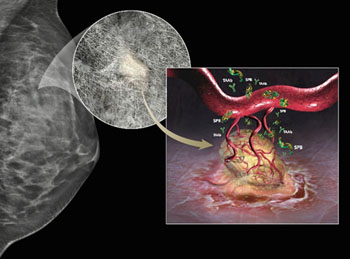Age Should Be Considered in Developing Diagnostic Assays
By LabMedica International staff writers
Posted on 23 Mar 2016
In a new study on breast cancer, blood test results have demonstrated age-related differences in Tumor-Associated Antibodies (TAAbs), showing for the first time age-related differences that should be taken into consideration when developing diagnostic tests.Posted on 23 Mar 2016
Data and results from the study, by Provista Diagnostics, Inc. (New York, NY, USA), were presented in a poster at the 2016 Miami Breast Cancer Conference (Miami Beach, FA, USA). The researcher team examined the TAAbs and Serum Protein Bio-markers (SPBs) of 492 women between the ages of 25–75 who received a BI-RADS 3 (probably benign) or BI-RADS 4 (suspicious) assessment upon diagnostic imaging. Age-related differences were found in the majority of individual protein biomarkers even when accounting for breast density and cancer prevalence.

Image: The Videssa Breast diagnostic test provides accurate early detection and typing of breast cancers by combining anatomical evidence from imaging with evidence from its proteomics test for proteins released into the blood system by cancer tumors (Image courtesy of Provista Diagnostics).
The data further suggests that age 50 serves as a strong guide to when TAAb expression changes may occur as hormone level changes associated with menopause may be a factor.
"While there have been studies showing age being a factor in SPB expression, we believe this is the first study to examine whether there were age-related differences in the expression of TAAbs," said lead investigator Kasey Benson, PhD, Provista. "This knowledge is extremely valuable as we continue to develop Videssa Breast—a blood-test that detects the presence or absence of breast cancer—for women of all ages." Videssa Breast analyzes a patient's SPBs and TAAbs and can improve detection of early breast cancer, irrespective of breast density. With the new results, Provista will now be able to produce two variations of Videssa Breast to account for age-related changes in TAAbs.
"The data allows us to produce blood-based tests to provide accurate results regardless of age," said Susan Gross, MD, Chief Medical Officer, "We have now evaluated Videssa Breast in more than 843 women to date and it has consistently shown a high degree of accuracy, when combined with imaging, in detecting the presence or absence of early breast cancers."
Videssa Breast uses Provista's patented ProteoMark technology that examines SPBs and TAAbs to detect breast cancer with high sensitivity and specificity. It is a proteomic test that analyzes blood for specific types of proteins emitted by cancer tumors. SPBs detection alone provides a high degree of certainty that cancer is present, but does not provide the evidence needed for typing. To provide specificity, Videssa Breast also measures the presence of TAAbs, involved in mounting an attack against the specific cancer cells. The unique signature of breast cancer TAAbs provides the certainty on cancer type.
The combination of imaging (anatomical evidence) with a proteomic approach (biochemical evidence) offers a powerful detection model, and reduces the rate of both false negatives and false positives. Videssa Breast transforms breast cancer detection and brings clarity to imaging results.
Related Links:
Provista Diagnostics
Videssa Breast














